What is a Generative Pre-trained Transformer?
By now, everyone has heard about #ChatGPT4 and all the ways this tool will disrupt the world, eliminate white collared jobs, and breed a new wave of “know-it-alls”. For some, this may be a bleak outlook of our future without knowing how AI will infiltrate our everyday lives, (very similar situation when the internet first appeared), but for others tethered to computers and the internet, this is the search engine we’ve all been looking for…
Despite some of the possible “negative” consequences, this new tool opens up an opportunity for accelerated productivity and research. We are drowning in a sea of overloaded information, and our traditional methods are strained. This may be the new #Google as our search for information is simplified and more direct.
Even though this tool will lead you to an answer quickly, users must understand its capabilities and limitations in order to realize its benefits. Just like during the early days of search engines, we curated keywords and phrases for engines to interpret your needs, only to sift through a just few hundred million results…

Chat GPT can easily sift through the noise with very little guidance to find you the “right” answer quickly, which is great for quick questions and basic facts. However, once you start asking hard questions, it becomes obvious there’s a mysteriousness of ths tool that only data scientists understand. For the consumers of this information, we should still exercise caution about what “it” tells you to be “truth”.
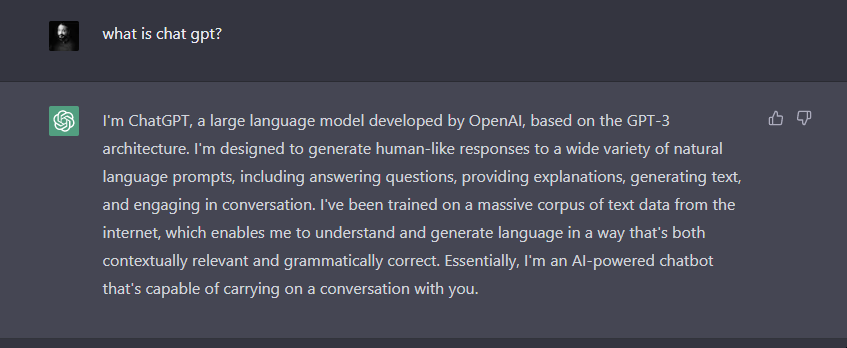
This new generative pre-trained transformer tool is great to answer all your silly questions, but if you don’t care about so much about “truth” and “facts” (and have plenty of remedial/redundant tasks to take care of), you can use this AI capacity to generate code specific to your needs. That in itself will avoid hours of sifting through #stackoverflow forums (only to realize you missed a closing curly bracket) and allow you to focus on higher lever challenges.
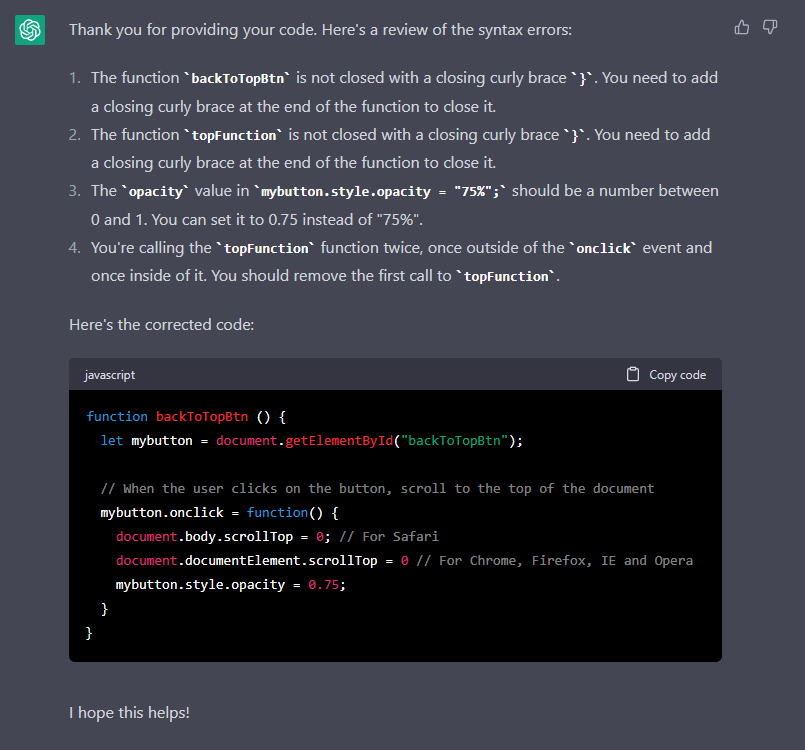
Bashing out Scripts
Finding facts, explanations, and information about the world may be great for our personal growth and awareness, but the real benefit from this tool is from generating low-code snippets without stumbling through syntax errors.
In the world of system administration, #bash scripting is a powerful tool and method of programming for system administrators, developers, and anyone else who works with command-line interfaces. Bash is ubiquitous in the computing world (comes native with Linux) and is heavily used to automate repetitive tasks, perform system maintenance, manage data, and creating workflows. All #Apple computers have Bash installed, and #Microsoft recently joined that bandwagon with its Linux Sub-System capability.
Like with any programming language, Bash scripts take time to write, test, and deploy. With Chat GPT, you can generate templates of codes and modify it for your needs.
For example, maybe you want to monitor the health of your site with a simple script that will ping your IP address every 5 minutes. Unless you write scripts regularly, you might need to consult your MAN page on your ping command, and stumble through all the syntax rules for building a conditional “While True” statement…
Or you can ask Chat GPT.
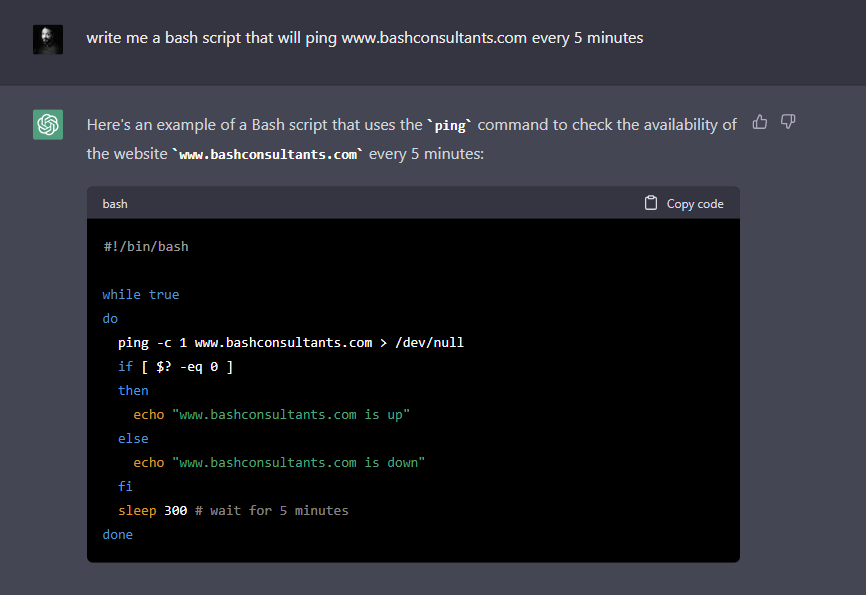
Those who code all the time, you may not be impressed with this example, but imagine if you had this tool during the early stages of your programming journey and avoiding all those hours dealing with syntax errors.
Don’t get me wrong. This tool by no means will make anyone a programmer overnight, but there’s a lot of potential for this tool to accelerate the learning process tremendously, and debug with ease. But of course, not all programmers can tap into this evolving technology just yet, and if you in graphic design, you might have to wait awhile…
Triangle Schemes
There are many people who are worried about AI technology obtaining human like super intelligence (for good reason) that leads to a situation where it could dominate or even enslave humanity… But, fortunately, we are still very far from that possibility as it requires a degree of imagination and cognitive abilities unique to humans.
We can see this from the many examples where these AI tools fail to respond to more advanced elements of logic, reasoning, and imagination, some of which are hilarious. All of which are delivered with absolute confidence, no fatter how obvious it is factually incorrect…

One can spend countless hours trolling this bot to highlight all the language blunders only humans can understand and laugh about, but I was more interested its ability to generate scalar vector graphics (normally stored as an “svg” file extension).
Of course, I wanted to test the boundaries, so I asked Chat GPT if it could generate digital renderings of an impossible 3D form. Unsurprisingly, the bot failed, but was it I who failed to teach this machine?
We’ll probably never know, but for fun, I chose the Penrose Triangle for its simplicity and geometrically scalar form, which I felt was reasonable to ask a computer to generate.
But expectations were still a little too high…
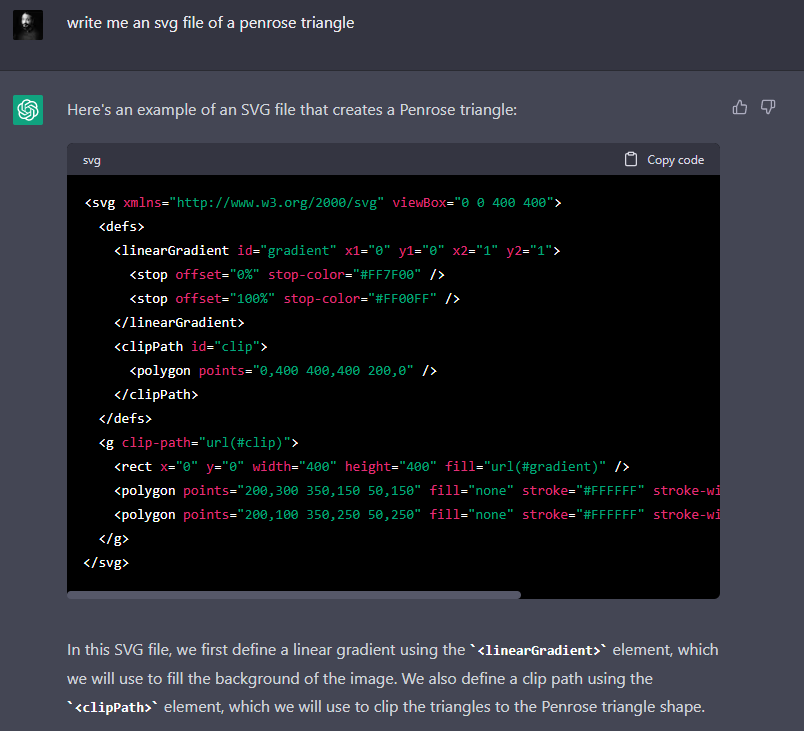
On the left side of the following image is the “Penrose Triangle” Chat GPT created, and the right side is an actual Penrose triangle I created.
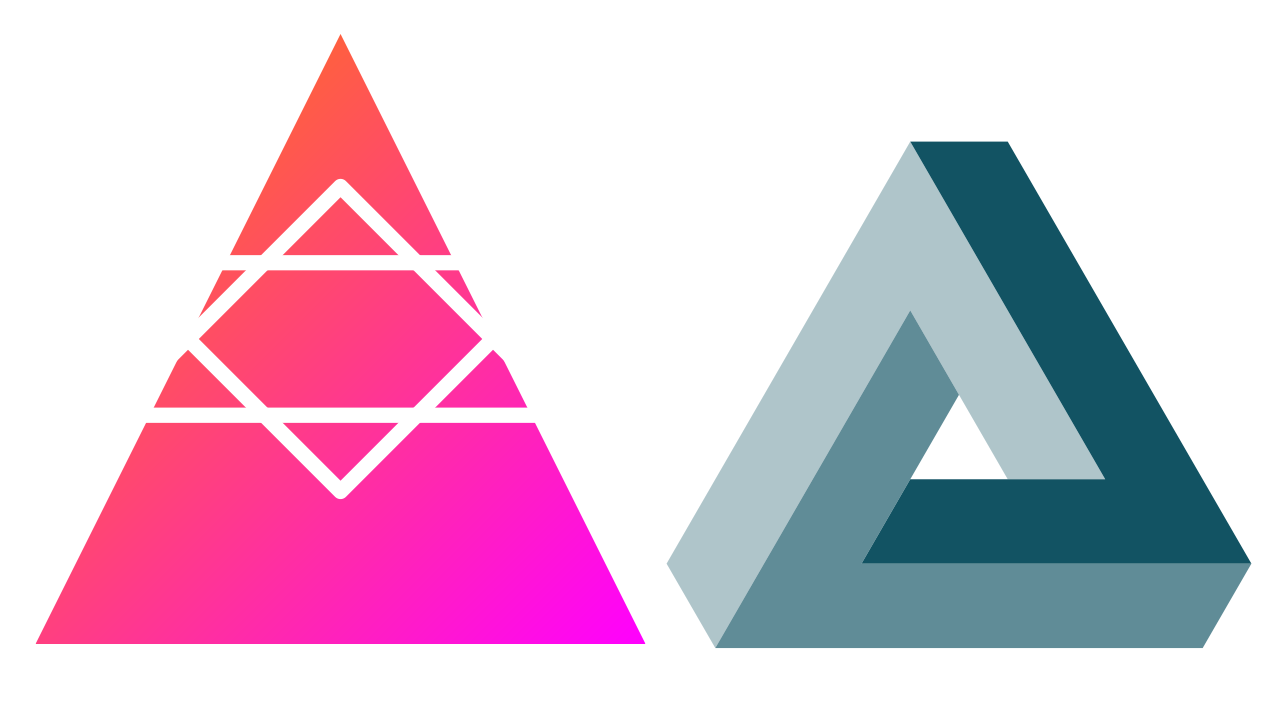
Just to make sure that this wasn’t just a misinterpretation of the request, I asked if it knew what Penrose triangle looked like. The written answer was spot on, but the text rendering was not even close.
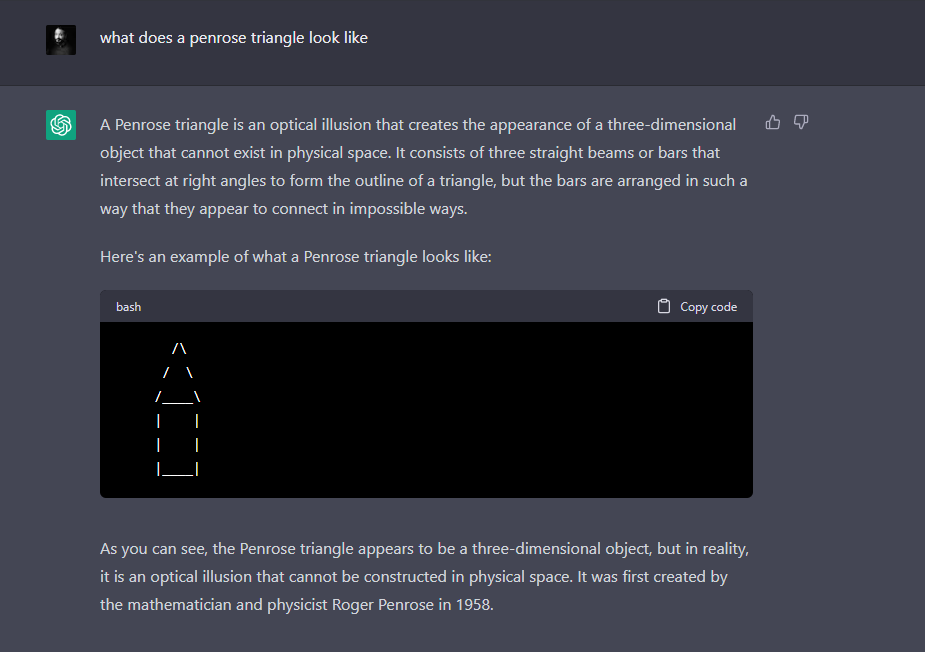
Even after all this, I had to admit I was still very impressed, mostly due to the fact that this tool generated responses within in seconds while I spent hours fumbling through InkScape.
Thoughts Overflow Error
The science behind AI is not new and the term has been used since the 60’s, but the computational powers/capabilities at the time were not conducive, and information/data was sparse. Now that we have overcome the technical hurdles, the time is now to harness the design and application of this new and “free” tool. We’re now in an era where AI machines will exponentially multiply the sea of information on the internet, some of which may be incorrect, biased, and possibly harmful to humanity. We should never lose sight of the over consequence of this new tool, and for those who may not benefit from productivity gains, I encourge you to familiarize yourself with this technology to understand the magnified societal impact.
To reallly understand the impact, you might want to ask yourself:
- How do I know the responses are correct, unbiased, scientific, and does not harm others?
- Who should control the AI algorithms and source code? Private or public
- How is this tool regulated to ensure information is democratized and accessible?
- Are we living the prequel of Minority report?
One good documentary to catch up on some of the negative consequences of AI/ML is titled “Coded Bias” on Netflix. This movie provides a bleak view of how AI technology has gone wrong today…
Summary Outlook, not email
Honestly, I’m not too familiar with the AI roadmap, and I have no idea what to expect in the next few years. However, I am very confident that it’s time for everyone to start experimenting this tool as it starts to evolve and improve. Just like in the early days of the internet, there’s a lot of potential, and those who understand how it works, will be the ones to ride the wave…
I guess the moral of this story is that we’re still in the “80’s” of AI technology, but at this rate, Chat GPT5 will take use to Y2K or beyond…
But, on the plus side, this bot is programed to be very polite.

Disclaimer: Chat GPT did NOT write this whole article for me.
2025 Update: The Evolution of AI Spatial Intelligence
Nearly three years have passed since this original article was written in March 2023. The AI landscape has transformed dramatically, and it’s time to revisit the Penrose Triangle challenge to see how far we’ve come.
The AI Renaissance: 2023 to 2025
When the original article was written, ChatGPT-3.5 and early GPT-4 were the cutting edge. The inability to generate a proper Penrose Triangle wasn’t just a quirky limitation—it represented a fundamental gap in AI spatial reasoning and geometric understanding. Fast forward to November 2025, and the AI ecosystem has exploded:
New Players on the Field:
- GPT-4 Turbo & GPT-4o: Enhanced reasoning and multimodal capabilities
- Claude 3 (Opus, Sonnet, Haiku): Anthropic’s sophisticated language models with improved spatial understanding
- Google Gemini: Deep integration with visual processing
- Specialized AI Tools: DALL-E 3, Midjourney v6, and numerous open-source alternatives
- Code-Specific Models: Cursor, GitHub Copilot, and specialized programming assistants
Revisiting the Penrose Triangle Challenge
The question that naturally arises: Can modern AI models now generate a proper Penrose Triangle?
The answer is… complicated.
What Has Improved
-
Better Geometric Understanding: Modern AI models demonstrate significantly improved spatial reasoning. They can now articulate the mathematical properties and visual illusion principles behind impossible objects with remarkable accuracy.
-
Enhanced SVG Generation: Today’s models are better at generating syntactically correct SVG code with proper structure, gradients, and transformations. The basic technical competence has improved dramatically.
-
Iterative Refinement: Current AI systems excel at taking feedback and iterating on designs. With human guidance, they can progressively improve their outputs through multiple rounds of refinement.
-
Multimodal Capabilities: Models like GPT-4o can now analyze images and understand visual concepts, allowing them to compare their outputs against reference images and adjust accordingly.
What Remains Challenging
Despite these advances, the fundamental conceptual challenge persists: truly understanding and representing impossible 3D geometry requires a type of visual-spatial reasoning that current AI architectures still struggle with.
Modern AI can:
- ✅ Explain what a Penrose Triangle is
- ✅ Describe how the optical illusion works
- ✅ Generate SVG code with proper syntax
- ✅ Create geometric shapes that approximate the concept
But it still struggles to:
- ❌ Internalize the “impossible” nature of the geometry
- ❌ Consistently place the visual elements to create the proper illusion
- ❌ Understand the precise depth cues and perspective tricks required
- ❌ Generate a perfect Penrose Triangle on the first try without human intervention
The Deeper Insight: AI vs. Human Spatial Cognition
The Penrose Triangle challenge reveals something profound about AI: it processes information fundamentally differently than human brains.
Human Approach:
- We “see” the impossible object in our mind’s eye
- We understand the visual trick intuitively
- We can imagine rotating it and examining it from different angles
- We grasp the concept of “impossible” in a visceral way
AI Approach:
- Processes geometric relationships as abstract patterns
- Lacks the phenomenological experience of visual perception
- Works through mathematical relationships and learned associations
- Attempts to match patterns from training data without true understanding
This isn’t a failing of AI—it’s a fundamental difference in how machine and biological intelligence operate.
Practical Applications: Where AI Excels Today
While the Penrose Triangle remains a fascinating edge case, AI has made tremendous strides in practical applications:
Code Generation Has Matured:
- Modern AI assistants can generate production-ready code across dozens of languages
- They handle complex architectural decisions and design patterns
- Error detection and debugging capabilities have improved exponentially
- Integration with development environments is seamless
Design and Creativity:
- AI-powered design tools have revolutionized digital art creation
- Text-to-image generation produces stunning, professional-quality results
- UI/UX design assistance has become mainstream
- Animation and video generation are now within reach
Problem-Solving Capabilities:
- Mathematical reasoning has improved significantly
- Scientific research assistance is increasingly valuable
- Complex data analysis and interpretation
- Multi-step reasoning and planning
The New Landscape of AI Limitations
The 2023 concerns about AI limitations haven’t disappeared—they’ve evolved:
New Challenges:
- Hallucination at Scale: More sophisticated models can generate more convincing but still incorrect information
- Overconfidence: AI systems remain confidently wrong, now with better vocabulary
- Ethical Concerns: Deepfakes, misinformation, and bias have become more sophisticated
- Environmental Impact: Training and running larger models consumes significant energy
- Job Displacement: The productivity gains are now tangibly affecting employment markets
Persistent Questions (Updated for 2025):
- How do we verify AI-generated content for accuracy and bias?
- Who controls the increasingly powerful AI systems? (Now with AGI discussions mainstream)
- How do we regulate AI while maintaining innovation and accessibility?
- What is the environmental cost of AI proliferation?
- How do we prepare society for AI that can perform most cognitive tasks?
The Silver Lining: Human-AI Collaboration
Rather than replacing human creativity and intelligence, the most successful applications of AI in 2025 leverage human-AI collaboration:
- Augmented Intelligence: AI enhances human capabilities rather than replacing them
- Creative Partnership: Artists and designers use AI as a collaborative tool
- Accelerated Learning: AI tutors and educational assistants democratize knowledge
- Accessibility: AI breaks down barriers for people with disabilities
- Productivity Multiplier: Routine tasks are automated, freeing humans for higher-order thinking
Testing Modern AI: The Experiment Continues
For those curious about the current state, here’s what testing in late 2025 reveals:
GPT-4 (Latest Version): Can generate geometric approximations and, with detailed iterative feedback, eventually produce something resembling a Penrose Triangle. Requires human guidance and multiple attempts.
Claude 3 Opus: Demonstrates excellent understanding of the concept and can generate sophisticated SVG code, but still requires iteration to achieve the visual illusion correctly.
Specialized AI Art Tools: DALL-E 3 and Midjourney can generate images of Penrose Triangles quite well (having been trained on many examples), but generating the underlying SVG geometry remains challenging.
Open Source Models: Rapidly improving, with some specialized models trained on geometric and mathematical concepts showing promise.
Reflections: Where We Stand in 2025
Looking back at the original 2023 article, several observations stand out:
- We Underestimated the Pace: AI progress from 2023 to 2025 exceeded most predictions
- We Got the Trajectory Right: The core limitations around true understanding vs. pattern matching remain
- New Tools Emerged: The ecosystem diversified beyond expectations
- Societal Impact Accelerated: AI integration into daily life happened faster than anticipated
The Penrose Triangle remains a valuable litmus test—not because it’s a critical use case, but because it highlights the boundary between statistical pattern matching and genuine spatial understanding.
Looking Forward: 2025 and Beyond
As we stand in late 2025, the conversation has shifted from “Will AI replace humans?” to “How do we ensure AI benefits humanity?”
Key Focus Areas:
- Interpretability: Understanding how AI makes decisions
- Safety: Ensuring AI systems remain aligned with human values
- Accessibility: Democratizing AI tools and benefits
- Education: Preparing people to work alongside AI
- Ethics: Establishing frameworks for responsible AI development
The Penrose Triangle challenge teaches us that AI doesn’t need to be perfect at everything—it needs to be good enough at the right things, used responsibly, and integrated thoughtfully into human workflows.
Conclusion: The Journey Continues
The original article concluded that we were in “the 80’s of AI technology.” In 2025, we might be approaching the late 90’s—exciting progress is being made, the “AI bubble” discussions remind us of the dot-com era, and we’re seeing both tremendous innovation and concerning challenges.
The impossible triangle remains impossible for AI to generate perfectly without human guidance. But perhaps that’s not a failure—it’s a reminder that human creativity, spatial intuition, and understanding remain uniquely valuable.
As we continue this journey, the goal isn’t to replace human intelligence but to augment it, creating tools that help us solve problems we couldn’t tackle alone.
Final Thought: The bot is still programmed to be very polite, but now it’s also much more capable. Use it wisely.
2025 Update Disclaimer: This update was written with AI assistance (showing how far we’ve come!), but all analysis, insights, and conclusions reflect human judgment about the evolution of AI capabilities and limitations. The irony is not lost on us.